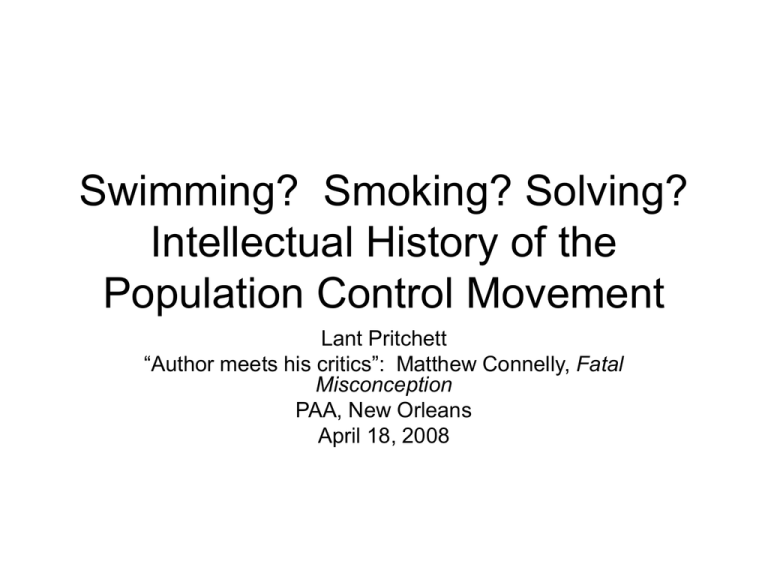
Swimming? Smoking? Solving?
Intellectual History of the
Population Control Movement
Lant Pritchett
“Author meets his critics”: Matthew Connelly, Fatal
Misconception
PAA, New Orleans
April 18, 2008
Intellectual History Helps Us Understand
Puzzling (Horrifying?) Events of the Past,
Disentangling Three Possibilities:
• Swimming: Fish don’t know what they are swimming in,
individual actions might be the result of a common, more
or less unquestioned milieu or zeitgeist which is now not
understood as “the past is a foreign country”
• Smoking: What were they smoking? Individual actions
were the result of the commitment of a few individuals to
a set of beliefs which, at the time, seemed aberrant and
unsupported by “evidence” (e.g. abolitionists, early
Christianity)
• Solving: Actions which seem to us disturbing and horrific
were the best action given the difficult situation the
individual actors faced (e.g. slavery in the Constitution)
There were Four Strands/Factions of The Population
Control Movement—which have had diametrically opposite
evolutions over the 20th century
• Eugenics
• Population Bomb
• Women’s Rights
• “Sexualityism”
Eugenics and Population Bomb went from
swimming to smoking
Swimming: Widespread racism,
Ethnic and class prejudice,
Xenophobia
Eugenics
Swimming: Onset of rapid
population
Population
growth, rising environmental
concerns (e.g. 1970s),
Malthusianism, Economic Planning
Models (how to meet “needs”)
Bomb
Smoking: socially
unacceptable
to attribute any
differences to genes
Smoking: Only so many
times you can cry “wolf!”
(including today over price
spikes)
Love means never having to say
your are sorry, but c’mon
Wolf!
• Japan is overpopulated
• Famines
• Running out of resources
• Pollution will overwhelm us
• Planetary crisis
(e.g. climate change)
Oops
• Population from 83 mn to 127
mn, GDP per capita goes up 10
fold.
• Food glut
• Commodity prices fall
• Environment got much better in
rich countries in nearly every
dimension
• C=(C/P)*P—why focus on P?
P is stagnant/falling where C/P
is high
What happened in growth
theory/development economics to
cause us to lose interest
• Massive deceleration of growth in the 1980s—after decelerations of
population growth were already well underway (e.g. Latin America)
• Emphasis on the volatility of growth rates over time in countries—
sharp accelerations and decelerations—that slowly moving variables
(e.g. demography) cannot explain.
• Decreasing importance on “factors” and more on “productivity”
• Advent of theories (the “new” or endogenous growth) with
agglomeration or scale economies
• Clearly differential impacts of equivalent demographic shifts on
savings, investment, output per worker (e.g. the supposed
demographic “bonus” in East Asia was a demographic “bogus”
elsewhere
While population might be (or might not) be related to economic growth
and overall prosperity it clearly was not a primary phenomena
The other two strands of the movement were going
the other way—from fringe to mainstream
Swimming: Unacceptable to
Smoking: Women are obviously
even question that men and women are
equal and gender discrimination a Women’s Rightsthe weaker sex, need protection,
bedrock of family, etc.
major social ill.
Swimming: Limiting any
individual’s expression of
sexuality or sexual identity is in
and of itself a bad thing.
“Sexualityism”
Smoking: Sexual behavior had
to be limited to monogamous
marriage for the good of society,
encouraging sexuality is bad.
What do the new zeitgeist think
about “population control”
• If voluntary contraception is sufficient to reach
demographic goals they are for it.
• If voluntary contraception does not have any
impact on demographic goals—they are still for
it.
• If reaching demographic goals requires
involuntary contraception they are against it.
• If reaching demographic goals requires
incentives in population control motivated
programs—they are leery of it.
Simple story of Cairo in 1994: Current
swimmers dump current smokers and
“population control” is over
• Women’s rights and sexualityism no longer need the
upper class eugenicists and population bomb types to
justify contraception and “reproductive health”
• If “development” is “engendered” then “development is
the best contraceptive” is OK by them (and the evidence)
• The embarrassing aspects of the movement—India’s
emergency period, China, sex selective abortion, etc.—
can be pushed off the boat—”yea, what were they
smoking”
• Contraception “meets population targets and is also
good for women” becomes “is good for women, full stop”
But, who really beat the Catholics?
• The eugenics and population bomb types alone
never could.
• The easy and fun story is that “women’s rights”
did
• But the intriguing story, in but underplayed in the
book, is the phenomenal rise of “sexualityism”—
rivaling religion as a force—something we are
now truly swimming in
Teaching sex education to 8 year
olds…
The strange rise of “sexualityism”
• The expression of human sexuality is in and of
itself a positive good and limitations on that
expression are in and of themselves bad.
• From banning “Lady Chatterley’s Lover” in 1960
(!?) in the UK to pornographic movies in every
hotel room (thanks for being here anyway)
• The rise of “sexual orientation” as a protected
category of human behavior (like religion)
• The split of major religious denominations over
whether in principle one can classify sexual
practices as sin—that sexual behavior is a
“private” matter that religion should not intrude







